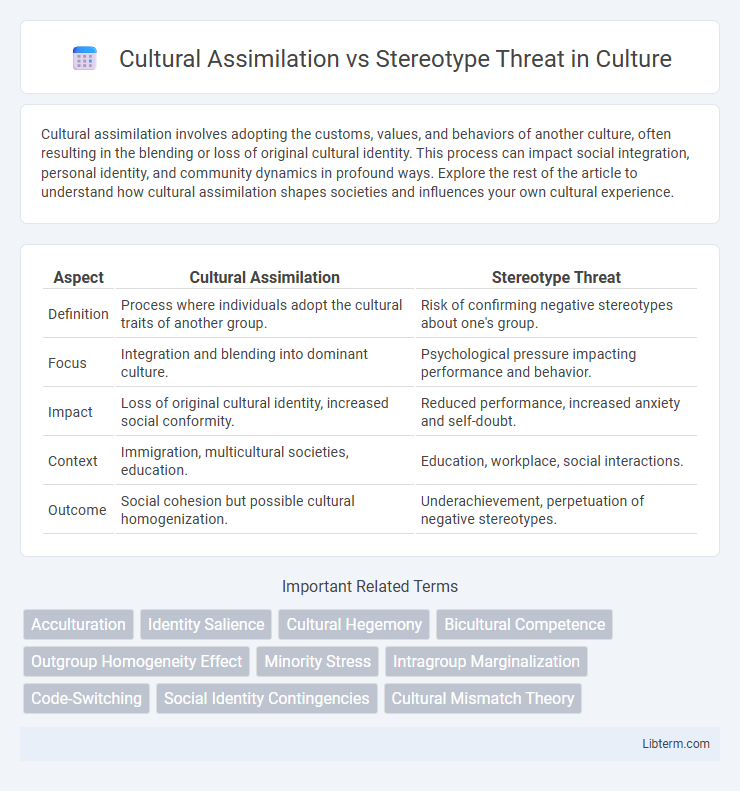Cultural assimilation involves adopting the customs, values, and behaviors of another culture, often resulting in the blending or loss of original cultural identity. This process can impact social integration, personal identity, and community dynamics in profound ways. Explore the rest of the article to understand how cultural assimilation shapes societies and influences your own cultural experience.
Table of Comparison
| Aspect | Cultural Assimilation | Stereotype Threat |
|---|---|---|
| Definition | Process where individuals adopt the cultural traits of another group. | Risk of confirming negative stereotypes about one's group. |
| Focus | Integration and blending into dominant culture. | Psychological pressure impacting performance and behavior. |
| Impact | Loss of original cultural identity, increased social conformity. | Reduced performance, increased anxiety and self-doubt. |
| Context | Immigration, multicultural societies, education. | Education, workplace, social interactions. |
| Outcome | Social cohesion but possible cultural homogenization. | Underachievement, perpetuation of negative stereotypes. |
Understanding Cultural Assimilation
Cultural assimilation involves the process by which individuals or groups adopt the cultural traits of another group, often leading to the loss of their original cultural identity. This phenomenon can be observed in immigrant communities adapting to a dominant culture's language, customs, and values to facilitate social integration and economic opportunities. Understanding cultural assimilation requires analyzing the balance between adaptation and preservation of cultural heritage, impacting identity formation and societal cohesion.
Defining Stereotype Threat
Stereotype threat refers to the psychological risk of confirming negative stereotypes about one's social group, which can impair performance and increase anxiety in affected individuals. This phenomenon often occurs in academic and professional settings where individuals fear being judged based on preconceived notions related to race, gender, or ethnicity. Understanding stereotype threat is crucial for addressing disparities in performance outcomes and promoting inclusive environments that reduce bias-driven stress.
Key Differences Between Assimilation and Stereotype Threat
Cultural assimilation involves adopting the behaviors, values, and norms of a dominant group to integrate into society, whereas stereotype threat occurs when individuals risk confirming negative stereotypes about their social group, impacting their performance and self-identity. Assimilation emphasizes conformity and integration as a path to social acceptance, while stereotype threat highlights psychological stress and decreased performance caused by awareness of stereotypes. Key differences lie in assimilation's focus on behavioral adaptation versus stereotype threat's focus on cognitive and emotional effects triggered by social biases.
Historical Context of Cultural Assimilation
Cultural assimilation historically involved policies such as the American Indian boarding schools in the 19th and 20th centuries, aimed at eradicating Indigenous languages and customs to integrate Native populations into Euro-American norms. European colonial powers imposed assimilation strategies on colonized peoples, undermining indigenous identities to consolidate control and promote Western cultural dominance. These historical contexts reveal a pattern where cultural assimilation functioned as a tool of social control, contrasting with the psychological consequences of stereotype threat experienced in marginalized groups today.
Psychological Impact of Stereotype Threat
Stereotype threat significantly undermines cognitive performance and psychological well-being by inducing anxiety and self-doubt in individuals from marginalized groups. This heightened stress response impairs working memory and executive function, leading to decreased academic and professional achievement. Moreover, the chronic experience of stereotype threat contributes to diminished self-esteem and increased risk of mental health disorders such as depression and anxiety.
Role of Identity in Cultural Assimilation
Cultural assimilation involves adopting the norms and values of a dominant culture, which can lead individuals to reshape their identity to fit social expectations. This identity transformation impacts self-perception and interpersonal relationships, often creating tension between maintaining cultural heritage and seeking acceptance. Understanding the role of identity highlights the challenges faced during assimilation, including vulnerability to stereotype threat, where fear of confirming negative stereotypes affects cognitive and emotional functioning.
Educational Outcomes: Assimilation vs Stereotype Threat
Cultural assimilation in education can enhance student integration and academic performance by promoting shared norms and reducing cultural barriers. Stereotype threat negatively affects educational outcomes by increasing anxiety and reducing cognitive capacity for students belonging to stigmatized groups. Understanding the balance between fostering cultural assimilation and mitigating stereotype threat is crucial for improving academic success among diverse student populations.
Social Consequences and Community Dynamics
Cultural assimilation often leads to the erosion of distinct cultural identities, causing tension within communities as individuals struggle to balance conformity with heritage preservation. Stereotype threat creates psychological barriers that limit individuals' social participation and reinforce existing social inequalities, deepening divides within community dynamics. Both phenomena significantly impact social cohesion, influencing trust, inclusivity, and the overall fabric of multicultural societies.
Strategies for Overcoming Stereotype Threat
Implementing identity-safe environments and promoting positive role models help reduce stereotype threat, enabling individuals from marginalized groups to perform at their best. Encouraging growth mindsets through feedback that focuses on effort and learning rather than fixed traits enhances resilience against negative stereotypes. Incorporating cultural competence training in organizations fosters inclusivity and mitigates anxiety linked to stereotype threat, improving overall performance and well-being.
Fostering Inclusive Environments Beyond Assimilation
Fostering inclusive environments requires moving beyond cultural assimilation to embrace diverse identities without forcing conformity. Addressing stereotype threat involves creating spaces where individuals feel valued and safe to express their authentic selves, reducing anxiety linked to negative group stereotypes. Organizations that prioritize psychological safety and cultural competence promote equity and enrich collaboration through genuine inclusion.
Cultural Assimilation Infographic

 libterm.com
libterm.com